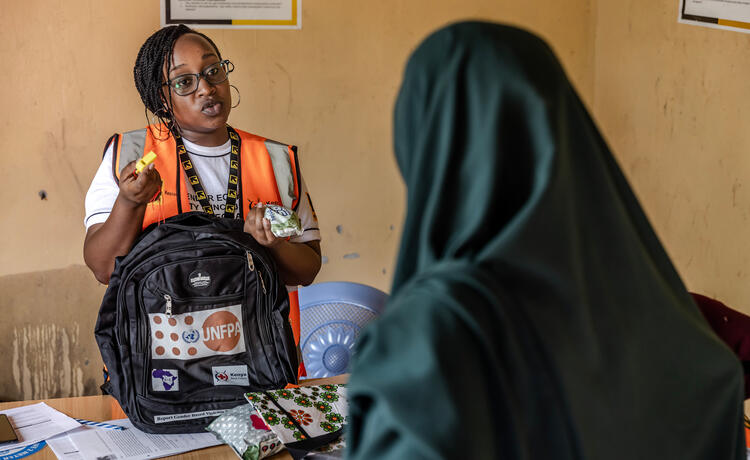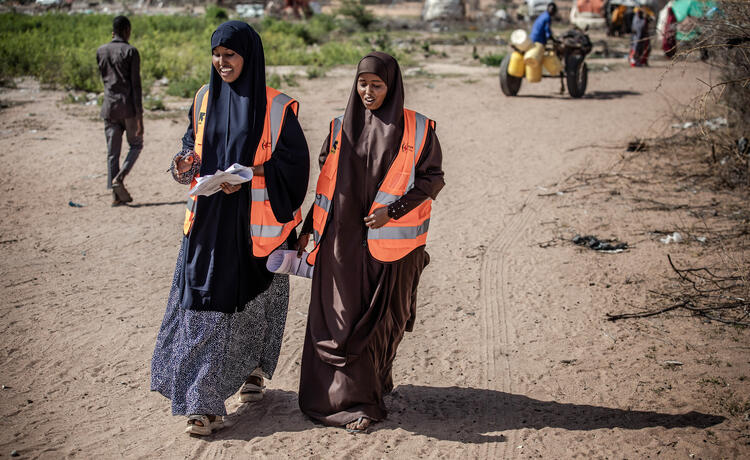News
Historic drought in the Horn of Africa: Women and girls fleeing one crisis for another
- 24 March 2023
News
DAADAB, Kenya – Incessant hunger and chronic insecurity forced Rukia Yaroow Ali and her nine children to abandon their home in Jilib, Somalia, to seek shelter at the Hagadera refugee camp in northern Kenya.
“My husband was a successful farmer, but when the drought hit, he wasn’t able to grow any food,” explained 38-year-old Ms. Ali. “The burden of providing for the family became too much, and there was constant friction between us. One day, he told me he was going out to look for work, but he never returned.”
Like Ms Ali and her family, more than 1.7 million people across the Horn of Africa have left their lives and homes behind as a relentless drought threatens to drag into an unprecedented sixth season of failed rains. Affecting more than 36 million people so far, it is one of the longest and most brutal droughts in recent history.

The majority of those displaced in Ethiopia, Kenya and Somalia are women and children. Untold numbers are now living in crowded, unsafe and unsanitary camps, exhausted and destitute after precarious journeys in search of food, water and survival.
“I came here with nothing, and could not even get food or shelter for my children,” said Ms Ali. “I still owe a debt to the man who transported us here. I don’t know how I’m going to pay him.” She and her children are currently living in a shelter constructed from sticks and cloth on the periphery of the Hagadera camp, alongside other new arrivals.
Multiple, overlapping health risks
Millions of families are under suffocating stress and hardship, with women and girls bearing a disproportionate burden. Basic but critical health and protection services have been interrupted in many areas, and essentials including contraceptives, menstrual hygiene products and even soap – where available – are being foregone to pay for food.
Family planning and maternal health care has been severely compromised, carrying potentially catastrophic consequences particularly for the more than 890,000 pregnant women who will give birth in the region over the next three months. In Somalia alone, nearly half of pregnant women who are displaced reported having no access to antenatal services, putting their lives and those of their children at severe risk.
Malnutrition among pregnant and lactating women is also at alarmingly high rates, increasing their risk of illness and severe, if not fatal, pregnancy complications. An estimated 140,000 pregnant and breastfeeding women in arid and semi-arid areas of Kenya, 400,000 in Somalia and a staggering 1.8 million in Ethiopia are acutely malnourished and need urgent assistance.
Violence rises as resources dwindle
In transit and temporary shelters, women and girls must trek far and often alone to fetch water or simply to find a toilet – journeys that are rife with danger and heighten their vulnerability to rape, abuse and exploitation.
Girls have no option but to drop out of schools they can no longer reach or afford, with teenage pregnancies reported to be rising as girls are forced into transactional sex to pay for food. Cases of female genital mutilation and child marriage also more widespread, since marrying off a daughter often means one less mouth to feed.

At the Hagadera camp, UNFPA supports screenings for gender-based violence among new arrivals, many of whom are unregistered and therefore unable to secure shelter or food rations. This makes them much more vulnerable to coercion and abuse, as they often have to rely on others to meet their basic needs.
“In August, a woman came to a health centre seeking help after she was raped by someone who had offered to house her and her children on arrival,” said Jane Ambale, from UNFPA’s partner the International Rescue Committee (IRC).
UNFPA supports an IRC gender-based violence recovery and protection centre for women and girls in Hagadera. The centre offers psychosocial assistance and referrals for medical care for survivors, and reached nearly 4,400 women in 2022.
Regular community outreach events are also held, where women discuss their protection and safety concerns. “Often, survivors are unaware of where to seek help, or afraid to speak up for fear of losing the support of the community. Our outreach events let them know that help is available, whenever they need it,” said Ms. Ambale.
Spiralling, life-threatening needs across the region
As communities struggle with the worst drought in four decades, existing gender inequalities and the dearth of sexual and reproductive health services are exacerbating an already dire situation and endangering the lives of thousands of women and girls.
The Horn of Africa is veering into uncharted territory as the drought catastrophe takes grip, stalking the lives of millions already dealing with protracted conflicts, locust infestations and escalating food and fuel prices. To meet soaring needs, UNFPA is scaling up delivery of life-saving reproductive health and protection services and supplies and has launched an appeal for $113.7 million for the crisis across Ethiopia, Kenya and Somalia.